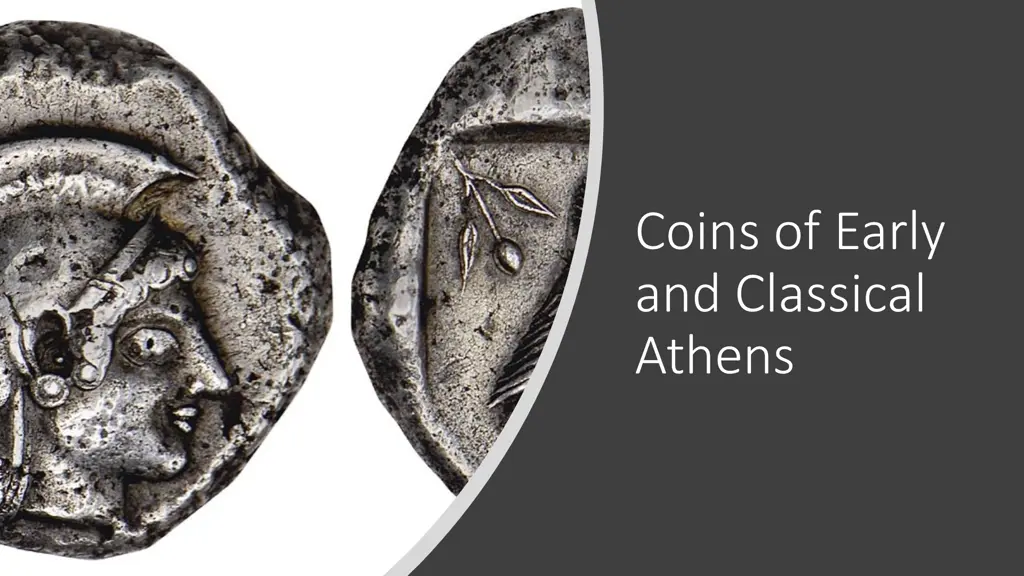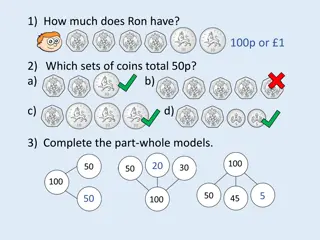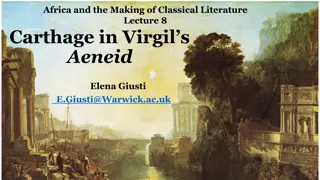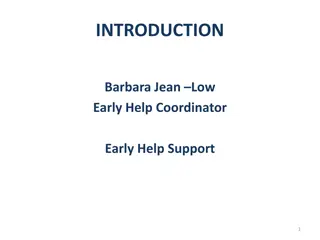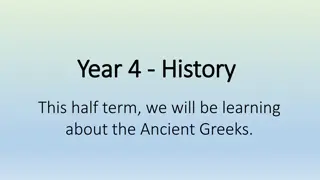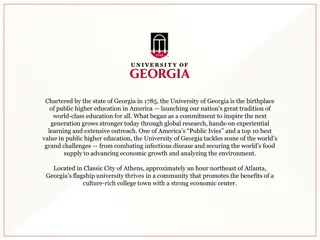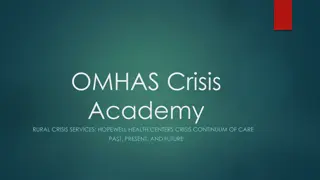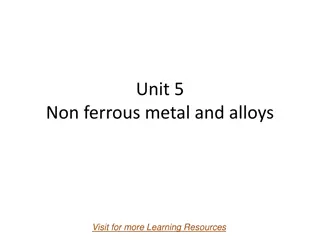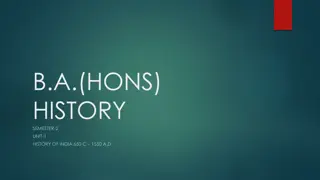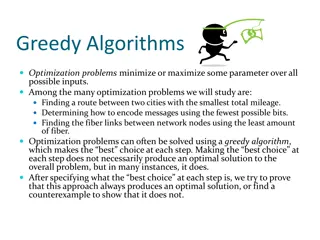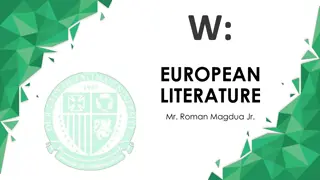Coins of Early and Classical Athens
Explore the evolution of Athenian coinage from early to classical times, reflecting civic values and community identity through silver currency. Discover the rich history and significance of these ancient coins.
Download Presentation

Please find below an Image/Link to download the presentation.
The content on the website is provided AS IS for your information and personal use only. It may not be sold, licensed, or shared on other websites without obtaining consent from the author. Download presentation by click this link. If you encounter any issues during the download, it is possible that the publisher has removed the file from their server.
E N D
Presentation Transcript
Coins of Early and Classical Athens
Wappenmnzen Wappenm nzen AR hemiobol, 0.3g, 515-510 BC. Wheel / incuse square. SNG M nchen 17. AR didrachm, 8.29g, c. 545-515 BC. Owl / incuse. R.J. Hopper, Observations on the Wappenm nzen , Essays to Robinson p. 32, 71a, pl. 5 AR obol, 0.66g, c. 525 BC. Gorgoneion facing / incuse. Svoronos pl. 1, 66-67
Laureion Laureion c. 520 BC onwards Heavier tetradrachm introduced Huge production of coinage throughout 5th century BC Mining was done by private operators who leased mines from the state and were presumably taxed on the amount of metal uncovered.
Athenian Owls Athenian Owls AR Tetradrachm, c. 17.61g, c.510 BC. Head of Athena / owl standing r., head facing, sprig of olive to l., ATHE to r. Svoronos pl.4.13
The cognitive life of objects The cognitive life of objects Extended mind hypothesis Thinking with and through things
Dokimasia examination Of citizenship Of coinage as legal tender character to engrave, to stamp, to be characterised by
The Athenian Imagined Community The Athenian Imagined Community
Kurke, p. 309 Once Athenian silver coinage is established as practice, its ongoing production and circulation not only reflect, but in some measure constitute, the community of citizens. Thus, in what we might call the micro-mechanics of ideology, material practices contribute to the civic imaginary, as pure silver coinage helps constitute the imaginary community of citizens who use it. As opposed to token bronze coinage, it asserts that civic order is more than just conventional; as opposed to bronze used at its full value or to debase the silver issue, it constitutes all citizens as the same noble substance. In contrast to gold, it rejects the elitist hierarchy of essence within the citizen body, while it imposes a firm boundary between the human, civic community and the domain of the gods. Finally, of course, its stamp implies that all citizens take shape from and submit to the civic authority that forms them.
Aristotle, Great Ethics I, xxxiii, 12 (1194a) (Melville-Jones 12) But since the builder s work is worth more than that of the shoemaker, and it was difficult for the shoemaker and the builder to exchange their work and it was not possible to buy a house with shoes, they settled upon a custom by which all these things might be bought, calling silver coinage nomisma (from nomos, custom), and using it; and by each giving the value of each thing, they created exchange with one another, and thus kept together the political association.
Uses of Money Uses of Money To pay for building work Purchase of sacrificial meat to be distributed at state festivals Payment of citizens for military, political and judicial service Aristotle, Constitution of Athens, XLI, 3 (Melville-Jones 67) At first they refused payment for attendance at the Assembly. But because people were not attending the Assembly, and the prytanies were devising many manoeuvres so that the multitude should attend for the carrying out of the voting procedures, first of all Agyrrhius provided an obol, and after him Heracleides of Clazomenae, called Basileus, two obols, and Agyrrhius again three obols.
Aristotle, Constitution of Athens, XLII, 2 (Melville-Jones 69) The following are paid: first the Demos for meetings of the Assembly one drachma, and nine obols for a sovereign meeting, then the jury courts three obols and the Council five obols. Those who serve as prytanies get an extra obol for food. Then the nine archons get four obols each for food, and have to maintain a herald and a piper; and the archon for Salamis gets a drachma a day. Directors of athletic festivals dine in the Prytaneum during the month Hecatombaeum at the time of the Panathenaic Festival, beginning on the fourth day of the month. Amphictyons for Delos get a drachma a day from Delos. All officials sent to Samos, Scyros, Lemnos or Imbros get money for food.
Money and Empire Money and Empire Use of Laurium silver to purchase fleet Money and the army (State-owned trireme navy from c. 515 BC (tyrant Hippias)) Transfer of the Delian treasury to Athens Tribute from other Greek cities Athenian standards/coinage decree
Herodotus, Histories 7.144 Another earlier idea of Themistocles was successful and well-timed, when the Athenians had a great amount of money coming to their public funds from the mines at Laurium, and proposed to distribute ten drachmas a man to each of them. Then Themistocles persuaded the Athenians to stop this distribution and to have two hundred ships built from this money for the war, meaning the one against the Aeginetans.
The Delian League (from 478/7 BC) The Delian League (from 478/7 BC) 1/60 reserved for Athena in Athens From 413 BC a 5% harbour tax Initially levied in the form of ships or any currency Transfer of treasury from Delos to Athens: most of the tribute paid in Athenian coin.
Athenian Empire in the 5 Athenian Empire in the 5th thcentury BC century BC
Athens Produces tetradrachms Returns as tribute / tax via trade (grain) or service in the military (even the fleet?) Allied States
Athenian Standards/Coinage Decree, 445 Athenian Standards/Coinage Decree, 445- -413 BC 413 BC Athenian coins, weights and measures used in Athens and allies of Athens Exception are those allies who used electrum coinage Old coinage had to be brought into the mint of Athens and re-coined for a fee. No evidence that the decree was effective.
Gold Coinage, 407/6 BC Gold Coinage, 407/6 BC 413 BC: Spartan occupation of the fort of Decelea in Attia, cutting off Athenian access to the silver mines. 14 talents of gold struck from the Nikes on the Acropolis IG II2, 1409, lines 4-6 (Melville-Jones 170). Accounts of the treasurers of Athena, c. 385/4 BC A wooden casket; a box in which are the dies and the little anvils on which they used to strike the gold coins, sealed with the public seal. drachm diobol and if everything else were exhausted, they could make use of the gold which was laid around (the statue of) the goddess. He pointed out that the statue had a weight of 40 talents of refined gold on it, which could all be removed. But, he said, if they used it to save themselves, they must put back again at least as much. Thucydides 2.13.305
Plated Bronze Coinage, 406/5 BC Plated Bronze Coinage, 406/5 BC
Aristophanes, Frogs 718-33 (Chorus) We have often thought that the same thing has happened to the city, in respect of the good and fine men among its citizens, as happened with the old coinage and the new gold. We do not make use of these coins, not counterfeit but the fairest, as it seems, of all, and the only ones struck well and ringing true among the Greeks and barbarians everywhere, but (we use) these wicked little bronzes, struck yesterday and the day before with the worst possible striking. And of those citizens whom we know to be noble and respectable, just and good and fine, reared in (the traditions of) the wrestling ground, the dance and music, we treat outrageously, and we make use of the bronze ones for every purpose, foreigners, red-heads, villians from evil stock, recent arrivals whom the city in the past would not have used even in the most random way as scapegoats.
Lucan, Nigrinus, prologue. (Melville-Jones 56) (owls to Athens.) The proverb says owls to Athens , meaning that it would be stupid for anyone to bring owls there, since they have so many. Xenophon Poroi 3.2 (trade in Athenian coinage) Moreover, at most other ports merchants are compelled to ship a return cargo, because the local currency ( ) has no circulation in other states; but at Athens they have the opportunity of exchanging their cargo and exporting very many classes of goods that are in demand, or, if they do not want to ship a return cargo of goods, it is sound business to export silver ( ); for, wherever they sell it, they are sure to make a profit on the capital invested.
Owls in Persian Egypt Owls in Persian Egypt Egypt, Persian administration, Sabakes. AR Tetradrachm, 16.88g, 340-333 BC. Head of Athena/ owl with head facing, olive sprig l., aramaic inscription (?) Sabakes symbol . Van Alfen type III.
Owls and Imitations... Owls and Imitations... P.G. van Alfen, "The 'Owls' from the 1989 Syria Hoard with a review of Pre-Macedonian Coinage in Egypt," AJN 14 (2002), pl. 11, 2.
Palestine Arabia
Law of Law of Nicophon Nicophon, 375/4 BC , 375/4 BC Money testers to sit beside the banker s tables in the agora and the Piraeus All coins brought forward to be deposited or exchanged to be tested Bankers had to accept genuine Athenian coins Foreign silver coins with the Athenian stamp should be approved, but then returned Plated imitations or counterfeit coins to be destroyed.
Athenian owls over time Athenian owls over time 4thcentury BC Stephanephoric / New Style Tetradrachms (165-42 BC)
Further Reading Further Reading Anderson, B. (2006). Imagined Communities: reflections on the origins and spread of nationalism. London. Aperghis, G. (2013). Athenian mines, coins and triremes. Historia 62.1, 1-24 Kallet, L., and J. Kroll, (2020). The Athenian Empire. Using Coins as Sources. Cambridge. Kroll, J. (1981) From Wappenm nzen to Gorgoneia to Owls. American Numismatic Society Museum Notes 26, 1-32 Kurke, L. (1999). Coins, Bodies, Games and Gold. The Politics of Meaning in Archaic Greece. Princeton. Lewis, D. (2008). The Athenian Coinage Decree. The Athenian Empire, ed. P. Low. Edinburgh. Melville-Jones, J. (1993). Testimonia Numaria. Greek and Latin Texts concerning Ancient Greek Coinage. London. Thompson, W.E. (1970). The golden Nikai and the coinage of Athens. Numismatic Chronicle 10: 1-6 Trevett, J. (2001). Coinage and democracy at Athens. Money and its Uses in the Ancient Greek World, ed. A. Meadows & K. Shipton, Oxford, 23-34 Trundle, M. (2010). Coinage and the transformation of Greek warfare. New Perspectives on Greek Warfare, G. Fagan and M. Trundle (eds), Leiden, 227-53
